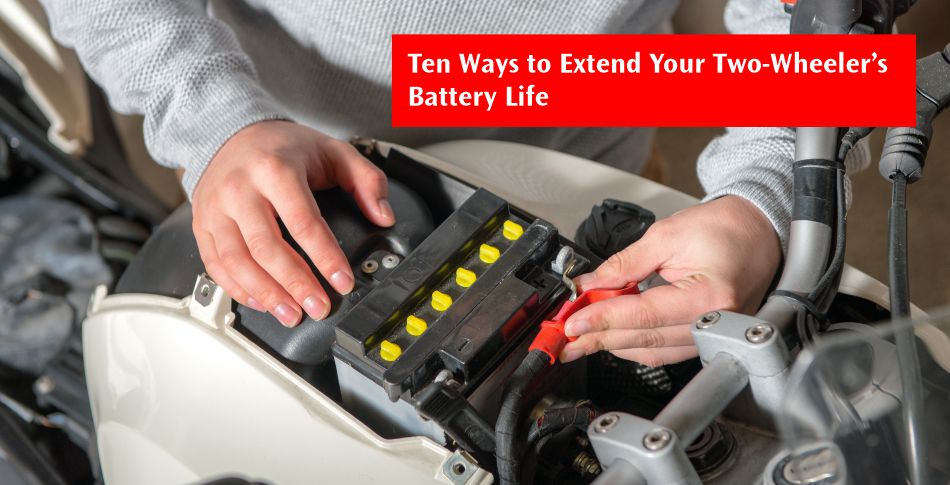Ten Ways to Extend Your Two-Wheeler’s Battery Life
Ten Ways to Extend Your Two-Wheeler’s Battery Life

The battery is a very critical component of your bike. It powers the self-starter system, headlamps, tail lamps, turn indicators and every other electrical system on the bike. Similar to your maintenance routine for your bike, including purchasing two wheeler insurance, you should take good care of your battery as well. Here are ten tips for better battery care:
1. Regularly check the charge levels: Like any other battery, a two-wheeler battery needs to maintain optimum charge levels for long life. Always check that your battery is kept well charged, as drained batteries tend to die early. You can use a multimeter to check charge levels at home. Leave the two-wheeler running on idle for 15 minutes to get decent charge levels.
2. Disconnect battery if not using the two-wheeler for a prolonged period: There can be many reasons for using your two-wheeler sparingly. However, if you plan to stow away your bike or scooter for later use, the best approach is to disconnect the battery. Disconnecting the battery when not in use prolongs its lifetime.
3. Regularly top-up the electrolyte in the battery: The electrolyte in a battery is used as you charge and discharge a battery. Over the cycles, you will need to top-up the electrolyte, or your battery will start to degrade. We advise periodic checking of your battery to note the electrolyte levels. Unless it is a sealed, maintenance-free battery, a regular two-wheeler battery will have multiple wholes to check and fill electrolyte. Upon inspection, if you notice lowering levels of electrolyte, ensure to top it up to avoid purchasing a new battery.
4. Avoid extra load on the battery: Many people tend to get their bikes fitted with high power-draining equipment like long-range headlamps and horns. Some even get portable DC to AC inverters to charge laptops on the go. All these kill your battery life that is not covered in bike insurance either. Avoid such modifications on your bike.
5. Regularly check and clean the battery terminals: The positive and negative terminals of the bike battery tend to collect calcium, carbon, and rust deposits over a period of time. These terminals need to be cleaned on a regular basis. Failing to clean the terminals can cause problems such as battery underperformance.
6. Do not overuse a two-wheeler battery: Overusing the battery can occur when you continue to use your bike battery without starting the engine. For example, the USB charger usage for mobile charging while the bike engine is turned off. Another case is leaving the headlamp of the bike switched on overnight by mistake. All these consume battery power and reduce its life.
7. Regularly check for wire health and short circuits: Many two-wheeler insurance claims arise because of electrical fires. The reason for these fires being improperly maintained cables and wires. Wires that are ripped or have their insulation worn off can cause short circuits. These can cause serious fire hazards. Thus, you must check the wires and cables once every year and replace those displaying signs of damage.
8. Do not use self-start all the time: While the self-starter system is one of the primary reasons bikes have batteries, it is also one of the biggest battery drainers. Almost all the bikes and scooters come equipped with a kick-start. It is best to use the kick-start at least three times for every seven times you use self-start. Further, regularly kick-starting the bike during winter mornings when the temperature is low also helps keep the battery healthy.
9. Regularly check cell-by-cell amperage: The cells in your battery work together to deliver appropriate current level. It is best to keep an eye on the current and amperes delivered by each cell because if a cell starts to underperform, it means your battery has some problem. This can be fixed by changing the electrolyte, but if not done in time, it will kill the battery within a few weeks.
10. Do not expose the battery to direct sunlight and rain: While automobile batteries are known to be built solid to withstand rugged conditions, it is best to avoid exposing them direct sunlight or rain. These may result in battery bloat or even explode. Besides, it will also degrade or rust the terminals.
Conclusion
Therefore, apart from bike servicing, there are simple tips that you can follow to ensure that your two-wheeler battery does not drain and die. For moments you do get stranded due to a dead battery, ensure to equip yourself with comprehensive bike insurance with emergency roadside assistance add-on cover to jumpstart your bike battery and dampened spirits!
Disclaimer: The above information is for illustrative purposes only. For more details, please refer to policy wordings and prospectus before concluding the sales.
This blog has been written by:
Mukesh Kumar | Motor Insurance Expert | 36+ years of experience in insurance industry
A veteran in the insurance industry, Mukesh Kumar has the expertise of handling various functions like Business Development, Underwriting, Claims, Human Resources, Quality Management and Marketing. With rich knowledge of the industry, he loves to share his views on topics of insurance sector and takes special interest in educating people on advantages of having insurance
Few Other Articles:
-
Reasons to kick-start your two-wheeler or bike every morning
-
Monsoon survival tips - how to keep your motorcycle smart and eco-friendly










 Health Insurance
Health Insurance  Travel Insurance
Travel Insurance  Car Insurance
Car Insurance  Cyber Insurance
Cyber Insurance  Critical Illness Insurance
Critical Illness Insurance
 Pet Insurance
Pet Insurance
 Bike/Two Wheeler Insurance
Bike/Two Wheeler Insurance  Home Insurance
Home Insurance  Third Party Vehicle Ins.
Third Party Vehicle Ins.  Tractor Insurance
Tractor Insurance  Goods Carrying Vehicle Ins.
Goods Carrying Vehicle Ins.  Passenger Carrying Vehicle Ins.
Passenger Carrying Vehicle Ins.  Compulsory Personal Accident Insurance
Compulsory Personal Accident Insurance  Travel Insurance
Travel Insurance  Rural
Rural 











